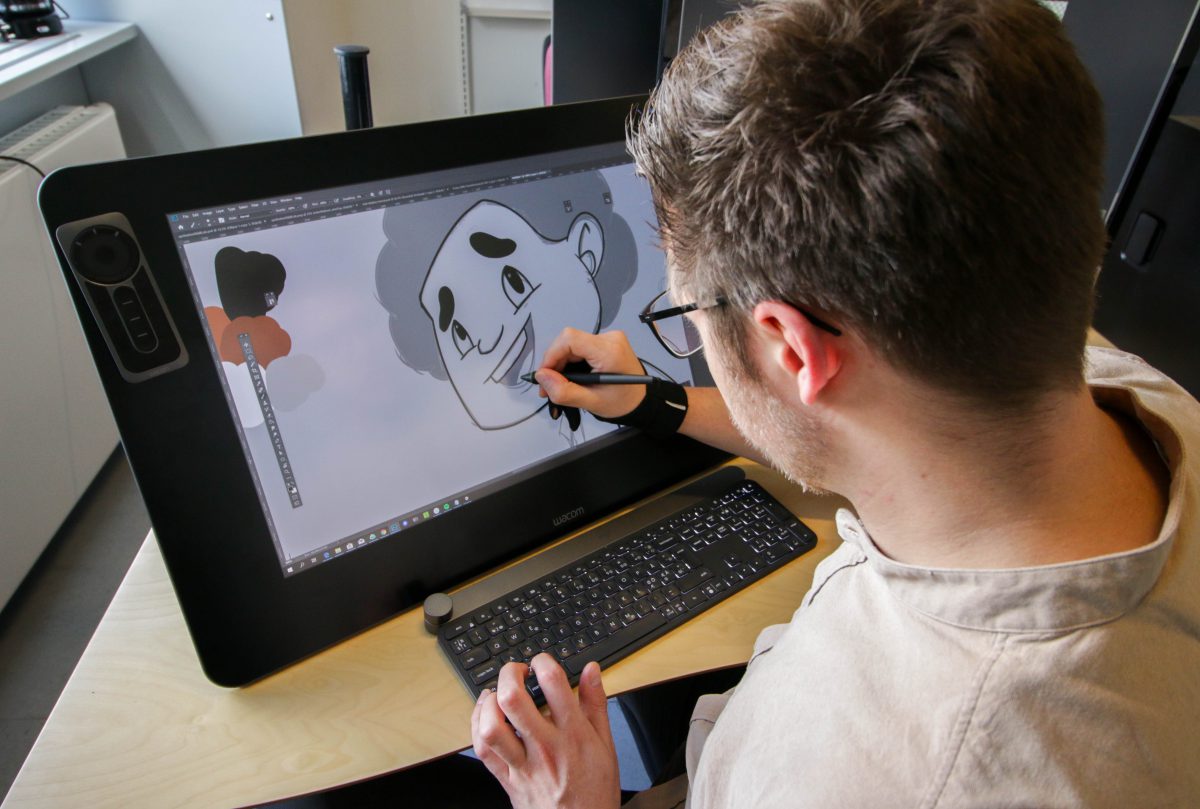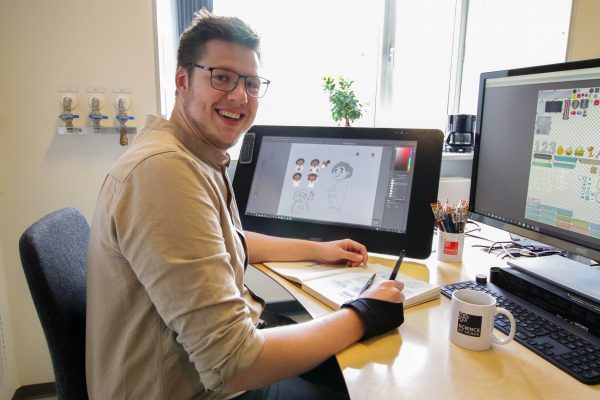
Designers’ toolkit
—From a digital "chalkboard" to a futuristic-looking screen
The art of design requires not only skills and imaginations but also some special digital tools that you don't find on a regular office desk. While most people are familiar with drawing on paper or painting with watercolors, digital design is a whole different world with different tools for beginners and advanced users, not to mention the requirements of the wide variety of design fields. ScienceAtHome's in-house designers, Peter Kjærgaard graphic artist and Plamen Petkov part-time designer alongside his studies share their evolution path as designers and their preferred tools for work.
Starter's kit
A digitizer is a kind of blank tablet—laymen eyes could mistake it for a chalkboard—with a special pen. This is the "simple but great" essential tool for digital designers that Plamen is working on an everyday basis. He is sharing his time between a regular mouse and a digitizer, depending on the given task. "While a regular computer mouse works the best for interface design when the previously done elements just need to be moved around, for more graphic elements and complicated assets, the digitizer is the must-have tool."
The drawing surface of the digitizer is connected to the computer and represents the screen surface. Though it's a practical tool to create graphical elements, it gives a challenge to the designers. "The difficult trick to get used to is looking up at the screen instead of down at your hand.”—says Plamen who has grown comfortable with this solution when he needs to design new elements from scratch or retouching photos. His brain is trained every day at work to coordinate tiny hand movements while he sees the results of it on a computer screen.
Plamen recommends all aspirational designers to start getting used to a digitizer as soon as possible, preferably with a cheaper, entry-level model. "The surface of these digitizers can easily get scratched, especially for new beginners just starting with the pen and getting used to touch sensitivity and how to tilt it for different line thickness. Also, an entry-level digitizer is a good start to investigate whether graphic design is your true passion or just a passing phase".
Advanced tools
The more advanced version of a digitizer is a pen display which is a colorful screen to draw on with a pen designed for this purpose. It looks similar to a tablet or a regular computer screen but it comes with a special pen, giving designers the true feeling of drawing. "Compared to the steep learning curve of a digitizer where you have to coordinate tiny hand movements while looking elsewhere, the pen display is a lot more natural and easy to start off with."—says Peter from his huge pen display on his work desk. It is connected to an arm stand, comparable to a robotic arm, which makes it possible to stand the screen up like any regular computer screen or position it down on the desk, comfortable for drawing on it. Peter, with years of experience in digital design behind his back, can create any assets for ScienceAtHome games, let it be artistic drawing, new characters or other elements. A pen display is the royal tool for designers but the high-end functionality brings along a great upscale in the price range as well.

Peter Kjærgaard working on new design assets for Skill Lab: Science Detective
The question comes naturally: when should a designer upgrade? "Upgrade as soon as you can afford it."—says Plamen who is working part-time as a designer but also still studying. His words hold a lot of meaning regarding affordability. Upcoming designers usually have some hard time landing their first jobs and getting their personal brand running. Many of the first years' gig probably won't cover the financial investment of a pen display. Still, no need to worry, even the entry level digitizers can create magic under expert hands. The key is training your skills just as you would train a muscle. Practice makes perfection!
Top 3 features to consider
Making the first choice for a digitizer can be overwhelming, so Plamen and Peter collected the 3 most important features you should look into! Considering these, you can make sure to get the best value for your budget!
- Size
The greater surface will give you plenty of space to draw. What's not to love, the bigger size often comes with higher input qualities and more shortcut keys. The result is more efficient work. Consider if you need to travel with it—in that case, the bigger size can turn into a pesky disadvantage. - Pressure sensitivity
Graphic tablets capture the motion of your pen as well as your pressure information. By 2019, most of the graphic tablets come with pressure sensitivity which tracks the amount of pressure, meaning when you apply pressure on the pen while drawing, it will render a thicker line. The more pressure sensitivity will give you more variety in the thickness of lines. Not to mention, more experience with details on your journey as a designer. - Controls
Many graphic tablets come with built-in keys that you can customize. While you are still able to use a laptop or computer key alongside, it's just much faster to program short keys right at your fingertips. Even some pens have function keys on them. What could be closer to reach than your most used shortcut key right under your thumb or index finger?
Need some design inspiration? Check out Skill Lab: Science Detective with a number of entertaining characters in various scenes and show us your character design work! Comment below or send us an email to support@scienceathome.org!
